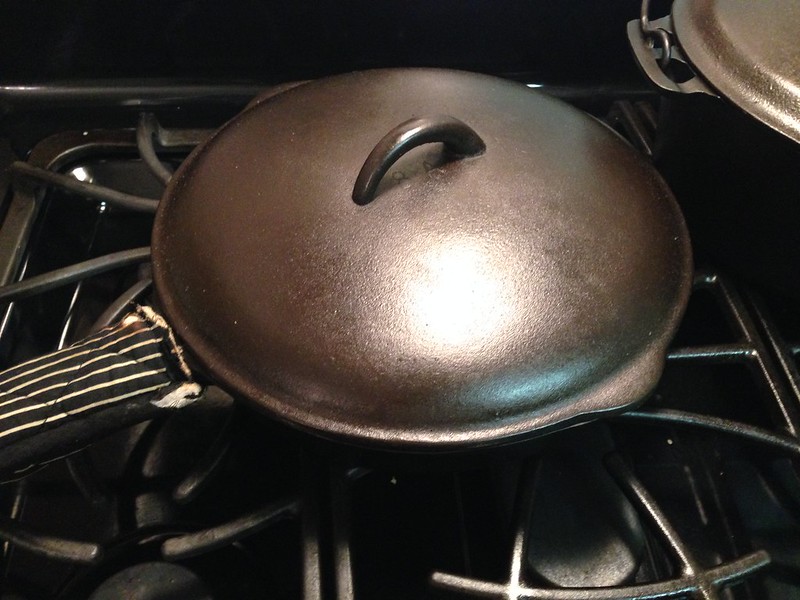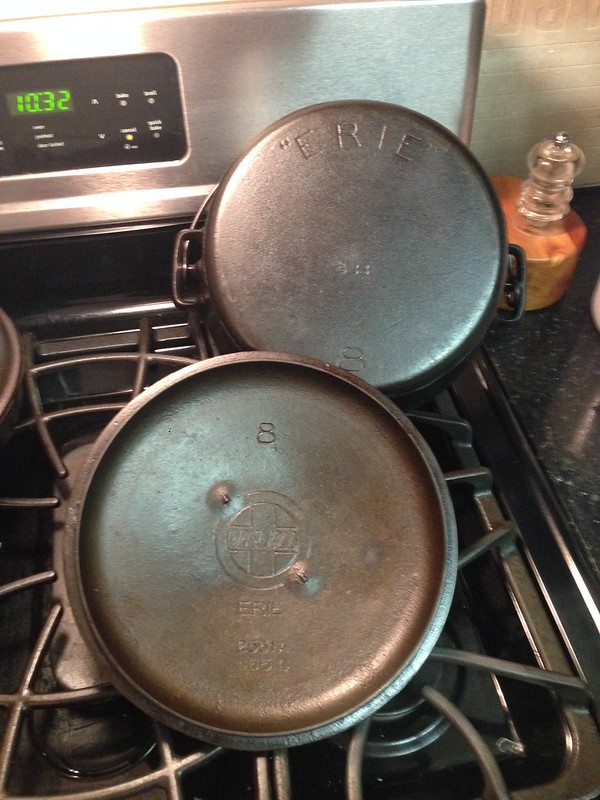1.) BSR Red Mountain #8 with matching lid
 image
image by
twillightkids, on Flickr
Absolutely and undoubtedly my most used piece. This one I found covered in rust sitting under a dumpster in a recycling yard. Nearly left it because it was a BSR and I was early in my collecting career and didn't appreciate it like I should have - I knew enough to recognize BSR but because I had delusions of stumbling across an Erie Spider or some such I almost let it lay there. I went back to it after looking through the rest of the yard and talked the owner into giving it up with the lid for $7. It cleaned up perfectly. It is, in fact, a perfect cast iron pan, in the way that most modern cooks think of cast iron. Relatively heavy, will not warp, but not a monster like modern pieces. Has a very smooth cooking surface. Heavy enough that it holds heat and cooks the way a modern cast iron recipe calls for, unlike older Griswold. This is an all arounder. I cook eggs, hash browns, burgers, chicken, etc., etc. in this pan and it is a wonder. THE classic cast iron skillet.
2.) Second series Erie, #10, bullseye maker's mark
 image
image by
twillightkids, on Flickr
This one is a bit of an embarrassment for me, as it is my only eBay piece for which I paid "market value". Actually, I tell myself I paid nothing for it, so it's all a matter of perspective. I had actually hunted down and salvaged several iron pieces (chief of which was a Lodge 90s bundt pan) and sold them on eBay for a massive profit. I in turn spent that on this skillet. I actually still netted money on the whole experience, although many would argue having the bundt pan in my collection would be better than this particular skillet. Nevertheless, I LOVE the Erie skillets that Griswold produced. This particular skillet has the finest polished sides I have ever seen on a cast iron piece. I feel like many people don't understand early Griswold, (at least through the LSL period and most of the LBL pieces I have handled). These skillets are NOT the classic cast iron pieces. They are very thin and do NOT hold heat like their heavier cousins. As such the limitations of cast iron are very apparent with these pieces - particularly with respect to uneven heating. Cast iron, being a very poor heat conductor, needs to be very thick to avoid major hot spots. The early Griswolds are anything but. As such you really have to understand these pans to use them appropriately. They excel when you use the hot spots to your advantage. Unlike heavy cast iron you can actually adjust heat settings quickly with these pans. Things like pan sauces are much easier to build in a thin skillet than in a thick heavy, because the pan can quickly adjust to changes in heat so much better than a heavy pan like the above BSR. This particular pan I use for searing meat, particularly when I want to deglaze and build a pan sauce. I also use it for occasionally cooking large batches of fried eggs, bacon, etc. Additionally I use it for tons of baking - brownie, cookies, bread puddings, and the like. Great pan.
3.) Unmarked Favorite or CHF skillet, #5
 image
image by
twillightkids, on Flickr
This one is a beauty, and, unfortunately, cracked. I picked this up at a junk shop in the neighboring state. Cleaning revealed a cracked sidewall, opposite the handle. This pan demonstrates that a cracked pan is not ruined. I use it for cornbread and for cooking meals for a single person. Much like the earlier Erie, this is a thin pan. It fries eggs like no other. We also use it as our cornbread pan, as my wife typically prefers to make small cornbreads. A fantastic little pan. Use and abuse your cracked pans, just use them wisely!




